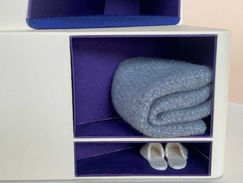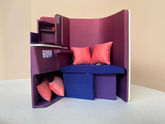Industrial Designer

The materials used in most cabin seats often play a supportive role in the seat’s functionality and experience, to achieve certain properties.

The role of surfaces in the aviation field so far, has been limited to that of passive properties privacy, comfort, sustainability and anti-bacterial properties.
However, what if we could make the surfaces of the seat take a more active role in the experience, rather than just providing a passive one?
Inspired by e-textiles and their ability to transform surfaces beyond their purpose, we decided to start by exploring its potentiality within the untapped aviation industry.
What if
We could redefine the role of a surface, in the context of a cabin seat, by giving it a more active role in the experience?

SkyWeave
Redefining surfaces
SkyWeave is a new cabin seat concept that interweaves materials and functionality. Utilising colour-changing fabric and e-textiles, SkyWeave breaks away from current physical interactions by turning the surfaces of the seat into tactile points of control.
Ambience and
Circadian considerations
Using Chromorphous fibres, the cushioned wall changes colour depending on the time of day, setting ambience and assists with the user’s circadian rhythm.
ChroMorphous Fibers
Developed by fiber-optic and fiber-device scientists in the laboratories of the University of Central Florida (UCF)
ChroMorphous fibers are weaved along with conductive threads into the fabric.
When an electrical current passes through the conductive threads, the fiber warms up slightly, activating its color-changing pigment.
Reverse-herringbone Layout
The reverse-herringbone layout grants users a greater sense of privacy by facing the seats slightly away from each other.

More Features

We estimate that SkyWeave can be produced within the next 10-15 years, opening up possibilities for a new type of cabin seat experience within airlines.
Making of 1:5 Scale Model















